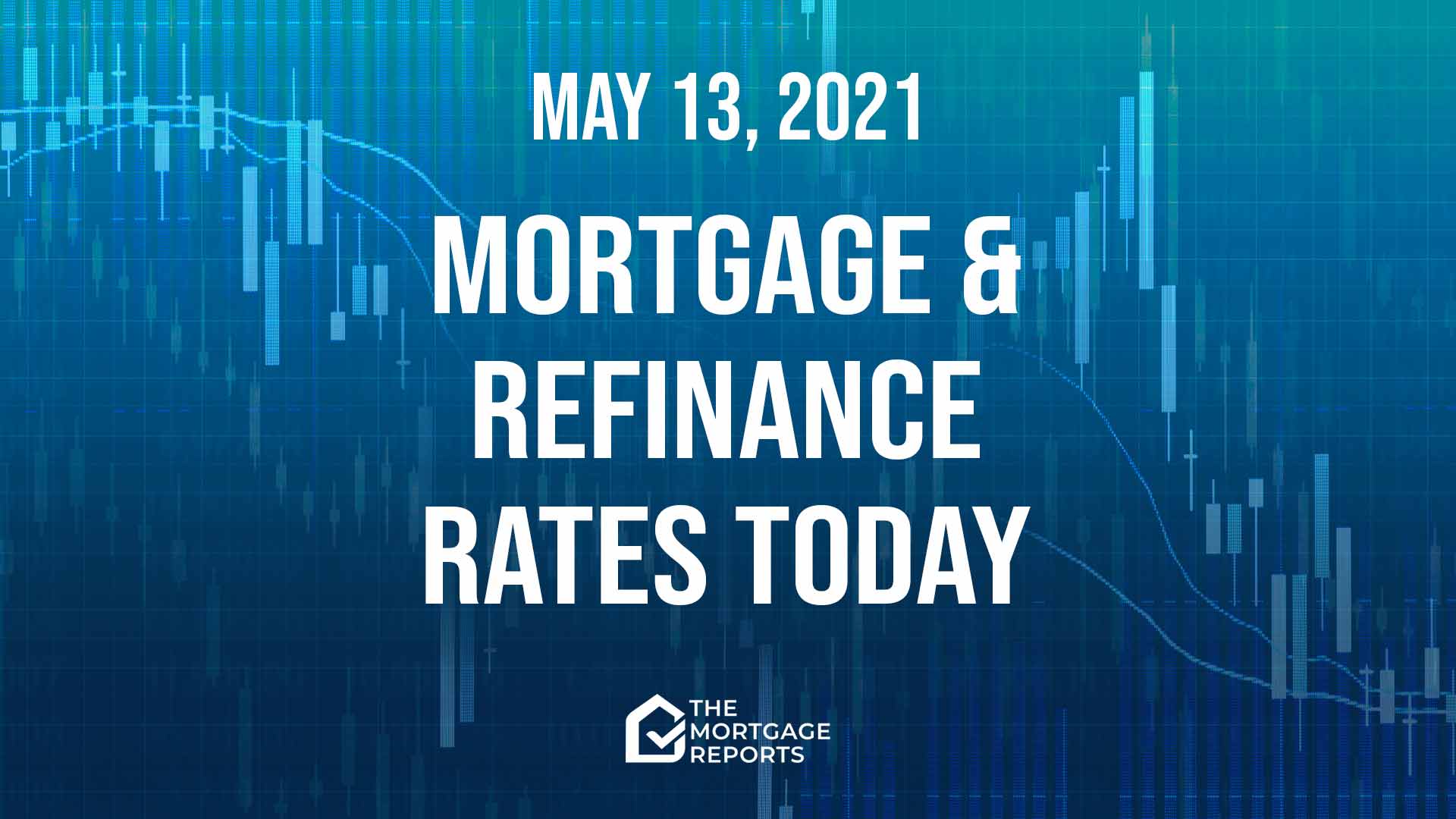
Today’s mortgage and refinance rates
Average mortgage rates increased again yesterday. And those rates are now at their highest so far in May.
In early trading, it was looking as if mortgage rates today may be unchanged or barely changed. But key markets have been volatile recently and a more “interesting” outcome remains possible.
Find and lock a low rate (May 24th, 2021)Current mortgage and refinance rates
| Program | Mortgage Rate | APR* | Change |
|---|---|---|---|
| Conventional 30 year fixed | |||
| Conventional 30 year fixed | 3.103% | 3.108% | +0.12% |
| Conventional 15 year fixed | |||
| Conventional 15 year fixed | 2.281% | 2.399% | +0.06% |
| Conventional 20 year fixed | |||
| Conventional 20 year fixed | 2.875% | 2.967% | +0.13% |
| Conventional 10 year fixed | |||
| Conventional 10 year fixed | 2.033% | 2.206% | +0.01% |
| 30 year fixed FHA | |||
| 30 year fixed FHA | 2.856% | 3.516% | +0.07% |
| 15 year fixed FHA | |||
| 15 year fixed FHA | 2.54% | 3.141% | +0.04% |
| 5 year ARM FHA | |||
| 5 year ARM FHA | 2.5% | 3.194% | Unchanged |
| 30 year fixed VA | |||
| 30 year fixed VA | 2.5% | 2.674% | +0.13% |
| 15 year fixed VA | |||
| 15 year fixed VA | 2.25% | 2.571% | Unchanged |
| 5 year ARM VA | |||
| 5 year ARM VA | 2.5% | 2.372% | Unchanged |
| Rates are provided by our partner network, and may not reflect the market. Your rate might be different. Click here for a personalized rate quote. See our rate assumptions here. | |||
COVID-19 mortgage updates: Mortgage lenders are changing rates and rules due to COVID-19. To see the latest on how coronavirus could impact your home loan, click here.
Should you lock a mortgage rate today?
Whether you locked three weeks ago or continued floating over that period, you can sigh with relief. Because you’ve lost or gained almost nothing. And, while there have been better or worse days on which to lock, the overall movement in these rates has been tiny.
What has remained constant has been the risk of a resumption in 2021’s rising trend. And, whether or not that has already begun, that risk remains high.
So my personal rate lock recommendations remain:
- LOCK if closing in 7 days
- LOCK if closing in 15 days
- LOCK if closing in 30 days
- LOCK if closing in 45 days
- LOCK if closing in 60 days
But I don’t claim perfect foresight. And your personal analysis could turn out to be as good as mine — or better. So you might choose to be guided by your instincts and your personal tolerance for risk.
Market data affecting today’s mortgage rates
Here’s a snapshot of the state of play this morning at about 9:50 a.m. (ET). The data, compared with roughly the same time yesterday, were:
- The yield on 10-year Treasurys held steady at 1.68% (Neutral for mortgage rates.) More than any other market, mortgage rates normally tend to follow these particular Treasury bond yields, though less so recently
- Major stock indexes were mostly a little higher on opening. (Bad for mortgage rates.) When investors are buying shares they’re often selling bonds, which pushes prices of those down and increases yields and mortgage rates. The opposite happens when indexes are lower
- Oil prices fell to $64.52 from $66.13 a barrel. (Good for mortgage rates*.) Energy prices play a large role in creating inflation and also point to future economic activity.
- Gold prices decreased to $1,820 from $1,834 an ounce. (Neutral for mortgage rates*.) In general, it’s better for rates when gold rises, and worse when gold falls. Gold tends to rise when investors worry about the economy. And worried investors tend to push rates lower
- CNN Business Fear & Greed index — Tumbled to 37 from 45 out of 100. (Good for mortgage rates.) “Greedy” investors push bond prices down (and interest rates up) as they leave the bond market and move into stocks, while “fearful” investors do the opposite. So lower readings are better than higher ones
Caveats about markets and rates
Before the pandemic and the Federal Reserve’s interventions in the mortgage market, you could look at the above figures and make a pretty good guess about what would happen to mortgage rates that day. But that’s no longer the case. We still make daily calls. And are usually right. But our record for accuracy won’t achieve its former high levels until things settle down.
So use markets only as a rough guide. Because they have to be exceptionally strong or weak to rely on them. But, with that caveat, so far mortgage rates today look likely to hold steady or just inch either side of the neutral line. And be aware that intraday swings (when rates change direction during the day) are a common feature right now.
Find and lock a low rate (May 24th, 2021)
Important notes on today’s mortgage rates
Here are some things you need to know:
- Typically, mortgage rates go up when the economy’s doing well and down when it’s in trouble. But there are exceptions. Read ‘How mortgage rates are determined and why you should care
- Only “top-tier” borrowers (with stellar credit scores, big down payments and very healthy finances) get the ultralow mortgage rates you’ll see advertised
- Lenders vary. Yours may or may not follow the crowd when it comes to daily rate movements — though they all usually follow the wider trend over time
- When daily rate changes are small, some lenders will adjust closing costs and leave their rate cards the same
- Refinance rates are typically close to those for purchases. But some types of refinances are higher following a regulatory change
So there’s a lot going on here. And nobody can claim to know with certainty what’s going to happen to mortgage rates in coming hours, days, weeks, or months.
Are mortgage and refinance rates rising or falling?
Today and soon
Every business journalist I’ve read reckons a fear of future inflation was behind recent turmoil in markets. “Investors brace for test of nerves as inflation worries mount,” says this morning’s Financial Times. And it continues: “Markets face uncertainty as economic growth adds to expectations of interest rate rises.”
But is there cause for optimism? Overnight, The Wall Street Journal may have found a glimmer. It quoted an analyst at State Street Global Markets, who said:
… a clearer picture would emerge only with a longer series of data on jobs and inflation. He said U.S. Treasury yields suggested that inflation expectations were still relatively contained.
— WSJ, “Inflation Concerns Rattle Global Markets, But U.S. Futures Gain” (paywall), May 13, 2021
Given that mortgage rates typically have a close relationship with yields on 10-year Treasurys, that may be a good thing. And, perhaps, investors are largely still buying the Federal Reserve’s line that recent, worrying inflation figures are just a sugar-rush following the latest stimulus measure. It thinks those numbers will settle down soon.
This morning’s producer price index for April was hotter than analysts had forecast. But markets appeared to shrug it off.
Still, it remains unclear what all this means for mortgage rates. I’d still pretty confident that they’ll rise at some point soon. But I’m not yet sure that recent increases mean they’ve already started on that sustained upward trend.
For more background, check out our latest weekend edition of this report.
Recently
Over much of 2020, the overall trend for mortgage rates was clearly downward. And a new, weekly all-time low was set on 16 occasions last year, according to Freddie Mac.
The most recent weekly record low occurred on Jan. 7, when it stood at 2.65% for 30-year fixed-rate mortgages. But then the trend reversed and rates rose.
However, those rises were mostly replaced by falls in April, though those have moderated since the middle of that month. Freddie’s May 13 report puts that weekly average at 2.94% (with 0.7 fees and points), down from the previous week’s 2.96%. But note that Freddie won’t have picked up on the rise on Wednesday that week.
Expert mortgage rate forecasts
Looking further ahead, Fannie Mae, Freddie Mac and the Mortgage Bankers Association (MBA) each has a team of economists dedicated to monitoring and forecasting what will happen to the economy, the housing sector and mortgage rates.
And here are their current rates forecasts for the remaining quarters of 2021 (Q2/21, Q3/21, Q4/21) and the first quarter of 2022 (Q1/22).
The numbers in the table below are for 30-year, fixed-rate mortgages. Freddie’s were updated on April 14, Fannie’s on April 12 and the MBA’s on April 22.
| Forecaster | Q2/21 | Q3/21 | Q4/21 | Q1/22 |
| Fannie Mae | 3.2% | 3.3% | 3.4% | 3.5% |
| Freddie Mac | 3.2% | 3.3% | 3.4% | 3.5% |
| MBA | 3.4% | 3.6% | 3.7% | 3.9% |
However, given so many unknowables, the current crop of forecasts might be even more speculative than usual. But, if any of those forecasts are to be proved right, rates will at some point have to rise quickly during the remaining seven weeks of the current quarter (Q2).
Find your lowest rate today
Some lenders have been spooked by the pandemic. And they’re restricting their offerings to just the most vanilla-flavored mortgages and refinances.
But others remain brave. And you can still probably find the cash-out refinance, investment mortgage or jumbo loan you want. You just have to shop around more widely.
But, of course, you should be comparison shopping widely, no matter what sort of mortgage you want. As federal regulator the Consumer Financial Protection Bureau says:
Verify your new rate (May 24th, 2021)Shopping around for your mortgage has the potential to lead to real savings. It may not sound like much, but saving even a quarter of a point in interest on your mortgage saves you thousands of dollars over the life of your loan.



